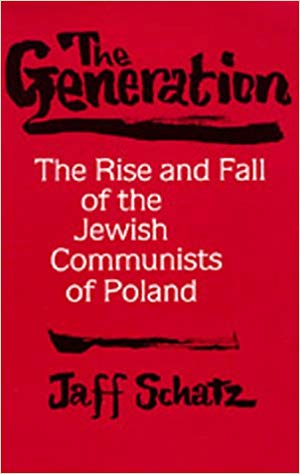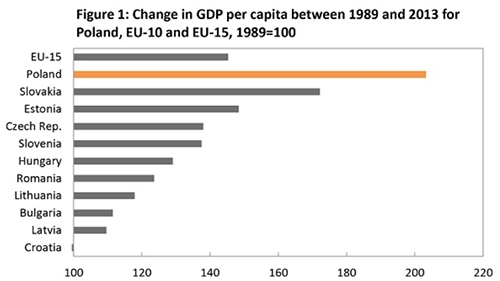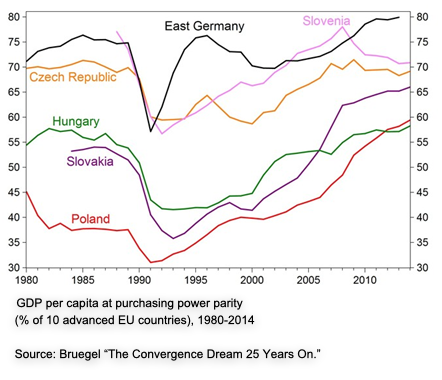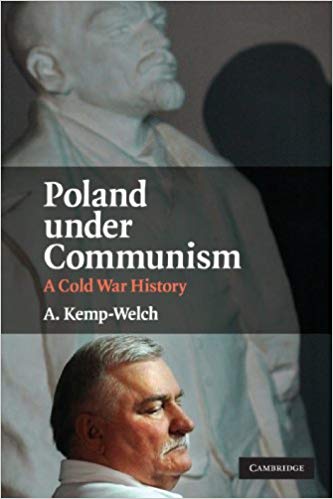In 1936, Germany under Hitler signed the Anti-Comintern Pact, in which they pledged to support any other signatories against communist Soviet aggression. Poland was invited to sign the pact, but didn't. Japan, Romania, Bulgaria, Croatia, Slovakia, and Hungary all signed the pact. Hitler, seeing the importance of Poland geographically in the struggle against Soviet Bolshevism, wanted the Poles to join him against the USSR but the Poles refused.
What started WWII in Europe was initially a territorial dispute between Germany and Poland, over land taken from Germany and given to Poland at the end of World War I. When the Germans marched into Poland in September 1939, Britain and France declared war on Germany, allegedly to "Protect the freedom of Poland" or "Protect the territorial integrity of Poland." When the USSR also invaded Poland in Sept. 1939, Britain and France did not declare war on the USSR.
In April 1943 the German Army discovered huge mass graves with tens of thousands of Polish leaders murdered by the Soviet NKVD. Hitler invited the International Red Cross and journalists from various neutral countries to review the evidence of this mass murder, but the American/British media blamed it on the Germans. After Germany's surrender, the Western allies, against US General Patton's advice, decided to allow Poland to be handed over to the same Communist butchers who massacred the Polish elite at Katyn and elsewhere. The Western Allies had two plans called "Operation Unthinkable" which, if successful, would have driven the Soviets from Poland, but they were cancelled. As a result, Poland became a Soviet satellite after WWII and the Polish people did not break free from communism until 1991. Additionally, Poland's post-war communist government was overwhelmingly dominated by the Jewish minority.
There is a book on the subject of Jewish domination of Polish communism:

Google Books: https://books.google.com/books/about/Th ... _R17Qmv7wC
Full book PDF: https://pdfhost.io/v/EsYhUb2Lo_The_Gene ... Poland.pdf or mirror1 or mirror2 or mirror3 or mirror4
Peter Myers has two great articles on the book. In one, he quotes various passages and provides his own comments. In the second, he quotes Kevin Macdonald's discussion of the book in 'The Culture of Critique':
Review of Jaff Schatz, The Generation: The Rise and Fall of the Jewish Communists of Poland
http://mailstar.net/schatz.html or https://archive.is/lSEml
Kevin MacDonald's review of a book by J. Schatz, The Generation: The Rise and Fall of the Jewish Communists of Poland (1991)
http://mailstar.net/poland.html or https://archive.is/T1v7Y
Some excerpts:
Schatz's (1991) work on the group of Jewish communists who came to power in Poland after World War II (termed by Schatz "the generation") is important because it sheds light on the identificatory processes of an entire generation of communist Jews in Eastern Europe. Unlike the situation in the Soviet Union where the predominantly Jewish faction led by Trotsky was defeated, it is possible to trace the activities and identifications of a Jewish communist elite who actually obtained political power and held it for a significant period.
The great majority of this group were socialized in very traditional Jewish families whose inner life, customs and folklore, religious traditions, leisure time, contacts between generations, and ways of socializing were, despite variations, essentially permeated by traditional Jewish values and norms of conduct.
...
Note the implication that self-deceptive processes were at work here: Members of the generation denied the effects of a pervasive socialization experience that colored all of their subsequent perceptions, so that in a very real sense, they did not know how Jewish they were. Most of these individuals spoke Yiddish in their daily lives and had only a poor command of Polish even after joining the party (p. 54). They socialized entirely with other Jews whom they met in the Jewish world of work, neighborhood, and Jewish social and political organizations. After they became communists, they dated and married among themselves and their social gatherings were conducted in Yiddish (p. 116). As is the case for all of the Jewish intellectual and political movements discussed in this volume, their mentors and principle influences were other ethnic Jews, including especially Luxemburg and Trotsky (pp. 62, 89), and when they recalled personal heroes, they were mostly Jews whose exploits achieved semi-mythical proportions (p. 112).
...
In the prewar period even the most "de-ethnicized" Jews only outwardly assimilated by dressing like gentiles, taking gentile-sounding names (suggesting deception), and learning their languages. They attempted to recruit gentiles into the movement but did not assimilate or attempt to assimilate into Polish culture; they retained traditional Jewish "disdainful and supercilious attitudes" toward what, as Marxists, they viewed as a "retarded" Polish peasant culture.
...
This combination of self-deceptive rationalization as well as considerable evidence of a Jewish identity can be seen in the comments of Jacub Berman, one of the most prominent leaders of the postwar era. (All three communist leaders who dominated Poland between 1948 and 1956, Berman, Boleslaw Bierut, and Hilary Minc, were Jews.)
...
While Jewish members saw the KPP as beneficial to Jewish interests, the party was perceived by gentile Poles even before the war as "pro-Soviet, antipatriotic, and ethnically 'not truly Polish' " (Schatz 1991, 82). This perception of lack of patriotism was the main source of popular hostility to the KPP (Schatz 1991, 91). On the one hand, for much of its existence the KPP had been at war not only with the Polish State, but with its entire body politic, including the legal opposition parties of the Left.
On the other hand, in the eyes of the great majority of Poles, the KPP was a foreign, subversive agency of Moscow, bent on the destruction of Poland's hard-won independence and the incorporation of Poland into the Soviet Union. Labeled a "Soviet agency" or the "Jew-Commune," it was viewed as a dangerous and fundamentally unPolish conspiracy dedicated to undemmining national sovereignty and restoring, in a new guise, Russian domination. (Coutouvidis & Reynolds 1986,115)
The KPP backed the Soviet Union in the Polish-Soviet war of 1919-1920 and in the Soviet invasion of 1939. It also accepted the 1939 border with the USSR and was relatively unconcerned with the Soviet massacre of Polish prisoners of war during World War II, whereas the Polish government in exile in London held nationalist views of these matters. The Soviet army and its Polish allies "led by cold-blooded political calculation, military necessities, or both" allowed the uprising of the Home Army, faithful to the noncommunist.
...
Moreover, as was the case with the CPUSA, actual Jewish leadership and involvement in Polish Communism was much greater than surface appearances; ethnic Poles were recruited and promoted to high positions in order to lessen the perception that the KPP was a Jewish movement (Schatz 1991, 97). This attempt to deceptively lower the Jewish profile of the communist movement was also apparent in the ZPP. (The ZPP refers to the Union of Polish Patriots - an Orwellian-named communist front organization created by the Soviet Union to occupy Poland after the war.) Apart from members of the generation whose political loyalties could be counted on and who formed the leadership core of the group, Jews were often discouraged from joining the movement out of fear that the movement would appear too Jewish. However, Jews who could physically pass as Poles were allowed to join and were encouraged to state they were ethnic Poles and to change their names to Polish-sounding names. "Not everyone was approached [to engage in deception], and some were spared such proposals because nothing could be done with them: they just looked too Jewish" (Schatz 1991, 185).
More will be posted in the future, that's all for now.
Related threads:
When the USSR invaded Poland, Britain was silent
viewtopic.php?t=7556
'Why Germany Invaded Poland', by John Wear / 'peaceful Poland' debunked
viewtopic.php?t=12331
Sources on Jews and Communism
viewtopic.php?t=12671
Polish Atrocities against Germans before 1. September 1939
viewtopic.php?t=7525






